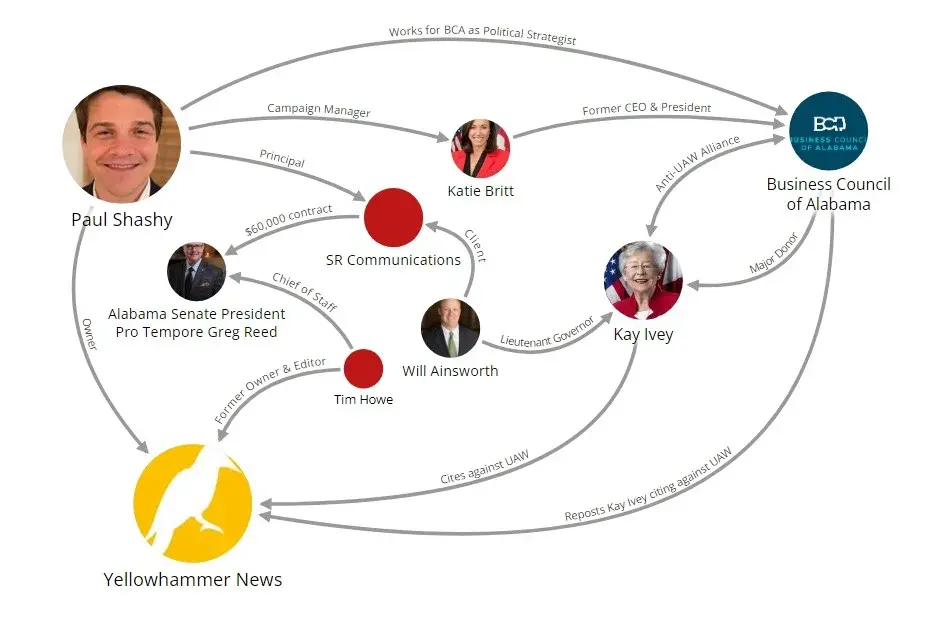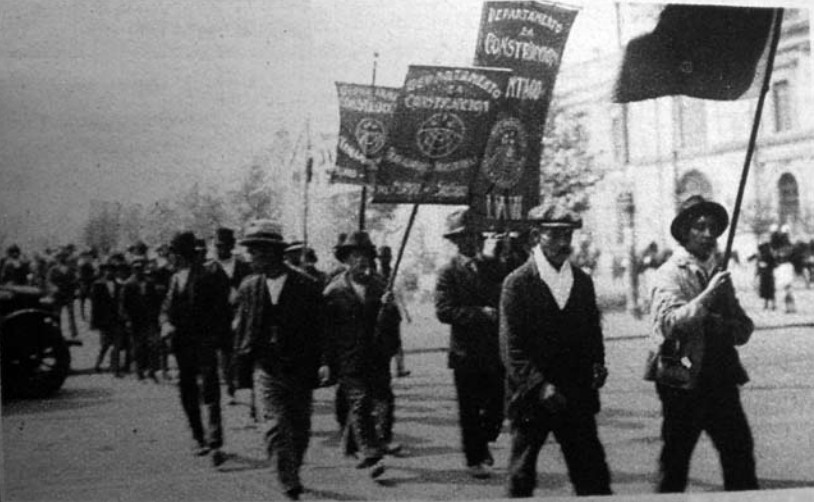Read the entire thing here:
Last week, Alabama Gov. Kay Ivey lambasted the United Auto Workers (UAW) in a social media post on X (formerly Twitter) ahead of a union vote at the Mercedes-Benz plant in Vance, Alabama, set for mid-May. Ivey has been campaigning for months against autoworker unionization in the state.
Ivey’s post referenced an anti-union op-ed by Nathaniel Ledbetter, speaker of the Alabama House of Representatives, to which Ivey added: “The UAW is NOT the good guy here. Thank you, Mr. Speaker, for calling out the UAW for what it is — corrupt, shifty and a dangerous leech.” Her post went semi-viral, garnering over 400,000 views, and it was reposted by her close political ally in resistance to autoworker unionization, the Business Council of Alabama (BCA).
While Ivey’s fierce opposition to the UAW is no secret, what was noteworthy about her post was the so-called media outlet she cited: Yellowhammer News.
Yellowhammer is no ordinary “news” site. It is co-owned by a longtime political consultant, Paul Shashy, who has deep ties to the Alabama political and business establishment, which is driving the opposition to the UAW. Indeed, in March 2023, the Business Council of Alabama, which is coordinating a statewide anti-union campaign, announced its hiring of Shashy as a political strategist.
None of this appears to be disclosed in Yellowhammer’s day-to-day coverage of topics, like the autoworker union drive, despite the owner’s apparent conflict of interest. Moreover, while Shashy purchased Yellowhammer in late 2023, its past owners have been lobbyists and consultants for major state politicians and executive directors of the Alabama GOP.
All told, the relationships between Yellowhammer’s ownership and Alabama’s anti-union politicians and business groups shed more light on what unionizing autoworkers are up against. Essentially, Alabama’s anti-union corporate forces have at their service one of the state’s biggest “media” networks, which is owned by someone who directly works for the BCA. As it churns out coverage and op-eds hostile to the UAW, those same corporate forces and their political allies can then invoke all this as “news.”
“A Partisan Site”: The Rise of Yellowhammer
On its website, Yellowhammer News claims to be “Alabama’s second-largest media outlet.” It tells advertisers that its news site has 57 million annual pageviews, 35,000 email subscribers, 25 radio affiliates and TV broadcasting to over 800,000 households. It has 107,000 followers on Facebook.
Yellowhammer describes itself as “Alabama’s preeminent outlet for news, analysis and much more.” It says it is “committed to delivering the news in a manner that reflects the state of Alabama, its people and their values.” Its catchphrase is “We know Alabama.”
But Yellowhammer is far from a regular news site. It has a documented history as a conservative operation owned and run by GOP political consultants and lobbyists with deep ties to corporate interests in Alabama.
According to a 2019 Columbia Journalism Review (CJR) story, Yellowhammer was founded in 2011 by a political consultant named Cliff Sims, who also served as the site’s CEO. Later revelations showed that two extremely well-connected lobbyists, Tim Howe and John Ross, were co-owners of Yellowhammer.
In January 2011, Howe and Ross became principals of an influential new lobbying firm, Swatek, Azbell, Howe & Ross. At the time, Ross was the executive director of the Alabama Republican Party, a position Howe also previously held. Their firm disclosed numerous clients that included prominent Alabama corporations, trade associations and advocacy groups.
It wasn’t known until 2014 that Howe and Ross were — in the words of the CJR story — the “benefactors” of Yellowhammer. This revelation came after Eddie Curran, an Alabama-based independent investigative journalist, published a leaked email with Yellowhammer CEO Sims seeking guidance from lobbyist Howe — referred to by Sims in the email as “Ghost Writer” — around a video that Sims was working on.
Yellowhammer’s ties to corporate power and the GOP were documented in the CJR story, which reported that Yellowhammer had received over $185,000 from advertising and in-kind donations from Republican PACs and political campaigns. Later investigations from NPR and Floodlight suggested links between Alabama Power, the state’s powerful electric utility, and Yellowhammer.
Yellowhammer has long been conservative in its orientation, but Curran told Truthout the site’s politics is not its main driver. “The issue with Yellowhammer is not its ideology, agree with it or not,” said Curran. “Think of the conservative politics as the bait. Yellowhammer’s true raison d’etre, so to speak — and for that matter, its business model — is as a pay-for-play operation.”
New Yellowhammer Owner Is a Republican and Business Consultant
In 2017, Yellowhammer’s founder, Sims, stepped down as CEO to join the Trump administration as assistant communications director for White House message strategy. In 2018, Sims was reassigned as senior adviser to Secretary of State Mike Pompeo.
Yellowhammer changed ownership in 2017 — Allison Ross, the wife of John Ross, became a co-owner — and then, in August 2023, another important new ownership change was announced.
Paul Shashy, a prominent Alabama political consultant, purchased the Yellowhammer media network, along with Thomas Harris, the former president and CEO of Merchant Capital. They moved Yellowhammer’s outlets into a new umbrella entity, YHN Media Group LLC.
Shashy was the campaign manager for both of Alabama’s sitting U.S. senators, Katie Britt and Tommy Tuberville. A 2018 Yellowhammer profile noted that Shashy had the “trust” of “the state’s biggest businesses and top-tier Republican candidates” and stated that “Shashy is going to be shaping Alabama elections and influencing the entire political scene for the next half-century.”
Shashy is a principal of the consulting firm SR Communications, which counts the Alabama Senate Republican Caucus among its clients. Alabama public records, which list Shashy as an “LLC member” of the firm, show that SR Communications has a $60,000 contract through December 2024 to provide “communications services” for the Senate president pro tempore, who is currently Alabama State Sen. Greg Reed. In August 2023, Tim Howe, the former lobbyist who was Yellowhammer’s former owner and editor, was appointed as Reed’s chief of staff.
Public records reveal that numerous other Alabama Republican political candidates and judges have paid tens of thousands of dollars to SR Communications, Shashy’s firm, over the past year alone, and over $350,000 since 2021.
For example, 13 filings from December 2021 through January 2024 show Alabama Lt. Gov. Will Ainsworth paid SR Communications a total of $21,100. In March 2024, Twinkle Andress Cavanaugh, Republican president of the Alabama Public Service Commission, filed a $10,000 payment to SR Communications for polling services. In November 2023, ProgressPAC, the Business Council of Alabama’s PAC, reimbursed SR Communications for a total of $2,089 as an “Expense Paid For GOTV In-Kind Contribution for HD16 Bryan Brinyark,” who was running for the Alabama House.
Filings show payments to SR Communications from numerous other candidates, ranging from state school board candidates to judges to members of the Alabama House of Representatives.
Shashy’s Yellowhammer co-owner, Thomas Harris, is also no minor figure. While leading Merchant Capital, it long ranked as Alabama’s top investment bank, managing over a billion dollars’ worth of government bonds, and was among the top financial underwriters in the nation.
Shashy, Yellowhammer and the Business Council of Alabama
A few months before Shashy purchased Yellowhammer, he was hired by the Business Council of Alabama.
“The Business Council of Alabama (BCA) is proud to announce the hiring of… Paul Shashy with SR Communications as political strategist,” said a March 2023 statement. Yellowhammer also wrote up the news.
As Truthout previously reported, the BCA is a statewide business association whose core 15-member governing leadership is composed of some of Alabama’s most powerful corporations, including the state’s biggest bank, electric utility and health care company. The BCA’s larger 135-member board includes representatives from automakers Toyota, Honda and Mercedes.
The BCA is a key player coordinating the statewide campaign against the UAW and autoworker unionization in Alabama. It started an anti-UAW website and has published anti-union op-eds. The BCA is also closely allied with Governor Ivey in resisting autoworker unionization. The BCA is one of Ivey’s top donors, and key corporations within the BCA governing leadership are also top Ivey donors. Top staffers of the Ivey administration formerly worked for the BCA.
Alabama’s Katie Britt was the CEO and president of the BCA from 2019 to 2021, after which she successfully ran for the U.S. Senate in a campaign managed by Shashy.
Yellowhammer coverage of the UAW has been hostile, using language that frames the union as villainous. For example, a March 4 op-ed by Clay Scofield, who stepped down last year as the majority leader in the Alabama Senate to work for the BCA, was titled “Even a small dose of labor union snake oil could prove poisonous to Alabama’s economy.”
An April 3 story by a staff writer on UAW President Shawn Fain was titled “Union boss escalates attacks on Governor Kay Ivey in tirade at North Carolina rally,” and referred to Fain’s “assault” on “Alabama’s Mercedes-Benz leadership, Governor Kay Ivey and the Business Council of Alabama.”
An April 9 story uncritically recited Alabama House Majority Leader Scott Stadthagen’s message that the “UAW’s Alabama expansion is an attempt to hijack state’s success.” The April 25 op-ed by Speaker Nathaniel Ledbetter that Kay Ivey cited warned about “the UAW’s trail of destruction” and its “legacy of corruption, destruction and usury.”
The list could go on. None of these articles appear to disclose that they were published while Yellowhammer’s owner is, according to the most recent publicly available records, working for the BCA, the group that is coordinating the statewide campaign, in close alliance with Kay Ivey, against autoworker unionization in the state.
In contrast, Yellowhammer’s coverage of the BCA is much rosier, with uncritical staff write-ups on BCA events and initiatives that essentially parrot the subjects they cover, whether that be the BCA members or BCA-allied politicians.
Truthout reached out over email to Yellowhammer News, Paul Shashy and the Business Council for Alabama for comment but did not receive responses from them.
“Corrupt” and “Shifty”?
All this brings us back to Kay Ivey invoking Yellowhammer in her campaign against autoworker unionization and the BCA reposting Ivey’s quip about the UAW being “corrupt, shifty and a dangerous leech.”
What this Truthout analysis reveals is that this well-known Alabama “media” outlet publishing anti-union content referenced by politicians and business groups resisting the UAW is, in fact, owned by a prominent consultant who works for these same anti-union forces and who is deeply embedded within their wider political operation.
These conflicts surrounding Yellowhammer as a new source offer a window into the wider influence machine of Alabama conservatives and business groups. Nor should the irony be lost that Governor Ivey calls the UAW “corrupt” while invoking such news sources.
Copyright © Truthout. May not be reprinted without permission.
Read the entire article. It's great and relevant.
Glad the UAW and several other unions are supporting the protests.



